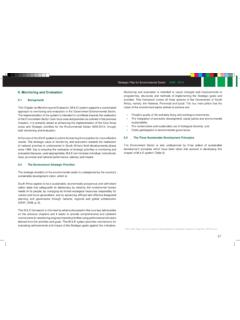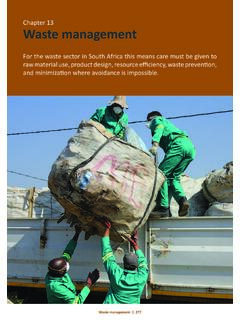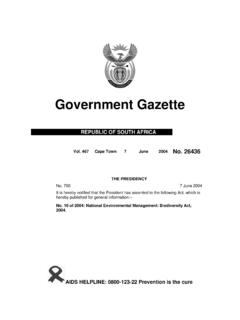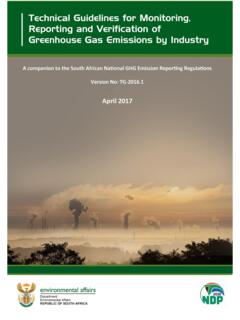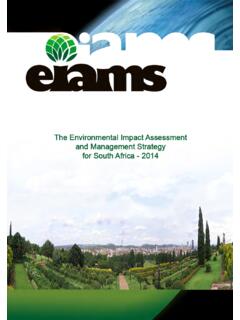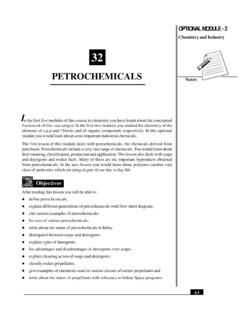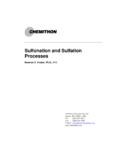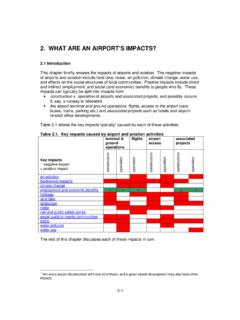Transcription of Chapter 10 Air quality - Home | Department of ...
1 Air quality | 181 Chapter 10 Air qualityThe atmosphere is the earth s largest single shared resource, which protects and supports life through the absorption of dangerous ultraviolet solar radiation, warming the surface and regulating quality | 182 Chapter 10 INTRODUCTION AIR quality Indoor air quality Ambient air SOURCES OF AIR POLLUTION Vehicle emissions Electricity generation and consumption Domestic fuel burning Industrial emissions Biomass burning Landfill site gas emissions Tyre burning emissions Airport emissions
2 Agricultural COMMON AIR POLLUTANTS IN SOUTH AFRICA AMBIENT AIR quality MONITORING IN SOUTH AFRICA Monitored pollutant concentrations Ambient air quality and associated impacts Regional and global issues Other pressing air quality RESPONSES TO AIR quality ANNEXURE 10. A: Ambient air pollutant INTRODUCTIONThe atmosphere is the earth s largest single shared resource, which protects and supports life through the absorption of dangerous ultraviolet solar radiation, warming the surface and regulating temperature.
3 However, these vital roles are under serious threat due to human-driven activities that result in the introduction of pollutants into the atmosphere (Hunter et al. 2002). These activities or drivers include industrialization, urban growth, population growth and changing consumption patterns. Significant sectors contributing to atmospheric degradation are transport, power generation, incineration, waste and biomass emissions requiring management on local and regional levels include sulphur dioxide, nitrogen oxide (NO) and nitrogen dioxide (NO2), carbon monoxide (CO), VOCs, benzene (C6H6), POPS and particulate matter.
4 Some of these primary pollutants undergo chemical transformation in the atmosphere, creating secondary pollutants such as sulphuric acid (H2SO4 - acid deposition) and ozone (O3). When dispersed by winds, these pollutants persist long enough to pose problems in distant areas, in some cases posing an additional problem of trans-boundary pollution (Hunter et al. 2002).Gaseous emissions such as carbon dioxide from fossil fuel combustion, methane and CFCs, while not directly hazardous to human and ecological functioning, are now recognized Air quality | 183as perturbing to the functioning of the atmosphere on a global scale.
5 Other global environmental challenges with local significance to South Africa include climate change, stratospheric ozone depletion due to CFC emissions, and mercury emissions from coal combustion for power generation and cement production. General environmental degradation and the depletion of natural resources are also major challenges facing the country and hence the drive towards resource management and of the reasons why air pollution is such a threat to human health is that we have no choice over the air we breathe (Koenig 2000).
6 Thus in our homes, outdoors and workplaces, we often breathe air which is not as clean as we would prefer. Inhalation is a route of entry into the body for toxic chemicals, resulting in respiratory illnesses such as asthma, increased susceptibility to acute respiratory infections, cancer, heart and lung diseases. Air pollution can cause a variety of environmental effects which include acid rain that can damage forests and crops, or acidify soil and water bodies, and eutrophication, a condition in a water body where high concentrations of nutrients, such as nitrogen, stimulates blooms of algae leading to death of fish (Koenig 2000).
7 AIR QUALITYIn South Africa, outdoor and indoor air pollution continues to be perceived as a serious problem, with emissions for sulphur dioxide, particulate matter, nitrogen dioxide, nitrogen oxides, ozone, benzene and VOCs, and the corresponding concentrations a cause of concern. Air quality in various areas of the country is affected by pollutants emitted by numerous sources. These sources include power generation activities, industrial processes, waste disposal, transportation (private and public vehicles), biomass burning, domestic fuel burning, landfill sites, waste water treatment and Indoor air qualityIndoor sources are the primary cause of indoor air quality problems in homes.
8 Poor ventilation can increase indoor pollutant levels due to weak dilution of emissions from indoor sources. There are numerous sources of indoor air pollution, including combustion of domestic fuels such as coal, wood, paraffin, tobacco smoke, asbestos products, pesticides used in the home, and household cleaning exposure to air pollution has been largely associated with outdoor pollution. However, the largest exposures to health-damaging pollution probably occur in the developing world among the poorest and most vulnerable populations, largely women and young children, who are most exposed to indoor pollution sources (Smith 2002).
9 The fact that domestic fuel burning occurs under unfavourable combustion conditions, often without venting to the outside, largely impacts on indoor air combustion for cooking and heating, using coal, wood, paraffin or traditional sources of fuel (dung and agricultural residues) may produce high levels of particulate matter (condensed volatile organic vapours) and carbon monoxide. Exposure to indoor air pollution is dependent on the type of fuel used, type of equipment used, location of the stove, and ventilation of the space (Smith 2002).
10 Resultant indoor pollution levels are extremely high, average daily PM10 concentrations in households can be up to ~1,000 g/m (WHO 2000), exceeding the World Health Organization s (WHO) and other international guidelines (WHO 2000). This is because incomplete combustion of the fuels results in the release of high concentrations of some air pollutants associated with combustion into the living Ambient air qualityAmbient air quality is defined as the physical and chemical measure of pollutant concentrations in the ambient atmosphere to which the general population will be exposed.
